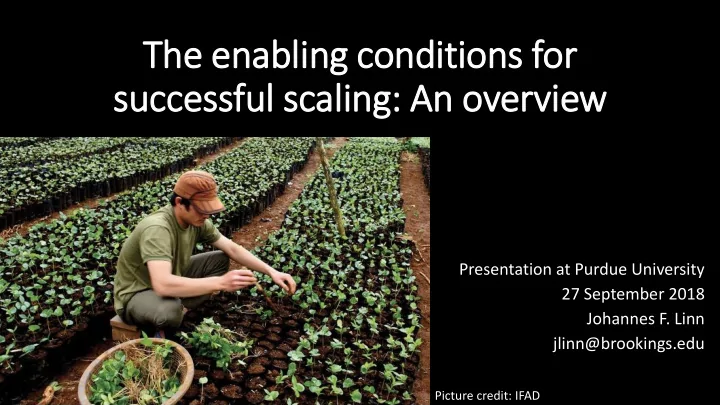

The enabling conditions for successful scaling: An overv rview Presentation at Purdue University 27 September 2018 Johannes F. Linn jlinn@brookings.edu Picture credit: IFAD
Scaling is part of an iterative process of innovation-learning-scaling up 10/4/2018 jlinn@brookings.edu 2
Six scaling stages help define a scaling pathway from idea to impact at scale How is this helpful? • Links research with implementation/application • Provides a common framework to map activities, deploy instruments, sequence interventions, and plan for systematic exit/hand-off • Enhances communication and collaboration among potential partners Source: IDIA 10/4/2018 jlinn@brookings.edu 3
Scaling up pathway -- innovation, vision of scale and enabling conditions 10/4/2018 jlinn@brookings.edu 4
Six key questions 1. What’s the problem to be solved, the vision and target of scale? 2. What ideas, innovations or models are to be scaled up? 3. What is the pathway to scale? • commercial, public, hybrid • horizontal, vertical, functional • expansion, replication, diffusion 4. What about the enabling conditions? 5. How about the sequencing of key steps? 6. Does M&E support learning for scaling up? 10/4/2018 jlinn@brookings.edu 5
Drilling down deeper on enabling conditions • Assessing the relevant enabling conditions is a key aspect of scaling up assessments. • Continuum of drivers-barriers (spaces) + _ Barrier Driver • Internal (to innovator/implementer/funder) v. external (environment, ecosystem) • Enabling conditions are context specific. • Relevant enabling conditions and their impact may change over the course of the scaling pathway – they have to be monitored and reevaluated continuously/intermittently throughout. • Enabling conditions for sustainability and scalability are closely related, but need to be assessed separately. 10/4/2018 jlinn@brookings.edu 6
Drivers • Idea that works + Vision of scale = Essential preconditions, but not sufficient • Champions/leadership (Borlaug, Yunnus, Aga Khan, etc.) • Weak leadership or a strong opponent can act as a barrier • A champion’s/leader’s exit can cripple scaling (WB) • Within funding institutions also (IFAD) • Incentives and accountability (profits, taxes/subsidies, regulations, competitions, RBF) • Negative incentives (taxes, regulations, etc.) can be a problem; short term positive incentives (subsidies) can be barrier in longer term • External v. internal incentives (to innovators/implementers and funders) • Incentives need to be matched by accountability (transparency, information, M&E) to be effective • Link to policy space 10/4/2018 jlinn@brookings.edu 7
Drivers (ctd.) • Market and/or community demand • Demonstration effect at market or community level a powerful force • Lack of demand can be a major barrier (cassava in W-Africa) • Export demand a potential safety valve (but import competition a possible barrier) • Link to policy space • External Factors (crises, donors, EU accession) 10/4/2018 jlinn@brookings.edu 8
Spaces (or barriers to be removed) • Political space • Winners and losers – supporters and opponents (stakeholder analysis) • Changes over course of scaling process (SEWA, education in Kenya) • Need to explicitly assess and address – evidence and advocacy (Progresa- Oportunidades) • Internal institutional politics matter (for innovators/implementers and funders) • Policy space • Legal/regulatory (dis)incentives (taxes, subsidies, etc.) • Access to domestic and foreign markets for inputs and outputs in value chain • Operational policies of implementing and funding institutions (link to institutional space) • Policies can also be entry point for scaling, i.e., systems change, but policy reform needs continuity and monitoring in implementation 10/4/2018 jlinn@brookings.edu 9
Spaces (ctd.) • Fiscal/financial space • Financial sustainability and scalability of the business model • Costs (down, up, steady) • Revenues (internal v external – fiscal/donor; predictability) • For funders: • How long to stay engaged and what happens after exit? • How to tailor financing instruments to different scaling stages? • Institutional space • Institutional commitment and capacity to scale (vision and strategy, operational policies, staffing, incentives, training, etc. for implementors and funders) • Institutional transitions from innovation to operating at scale • Facilitating institutions (role of funders as facilitators) 10/4/2018 jlinn@brookings.edu 10
Spaces (ctd.) • Partnership space • Without partners, no scale • Bring them in early (avoid NIH syndrome) • But choose/manage them carefully – partnerships aren’t easy/costless • Both implementers and funders have to partner • Appropriate partners will change across the innovation-scaling stages • Environmental space • Interventions at scale may impact environment or run into natural resource constraints – esp. in agriculture (water, soil) • Scaling up climate smart interventions – the environmental dimension is critical 10/4/2018 jlinn@brookings.edu 11
Spaces (ctd.) • Cultural space • Need to consider/address possible cultural constraints (including role of traditional practices and beliefs, risk aversion, gender roles, ethnic divisions, etc.) • Information space • Generating and using “internal” data through M&E • Using IT tools, RCTs, etc. • Not only on impact, but also on enabling conditions • Accessing and sharing “external” data through information scanning, networking, etc. • A scaling perspective provides greater incentives for effective information management (benefits of M&E are internalized) 10/4/2018 jlinn@brookings.edu 12
Use as a diagnostic tool: IFAD’s “Framing Questions” • IFAD developed (with Brookings) a systematic scaling approach, including • ”Framing questions” that focused on ideas, vision, drivers, spaces, pathways and IFAD’s role • Incorporated scaling systematically in its operational policies and M&E • In 2017 carried out a corporate evaluation of progress with mainstreaming scaling up approach 10/4/2018 jlinn@brookings.edu 13
Use as a dia iagnostic tool: : An example of f a scali ling up review of f the UNDP country ry Program in in Taji jikistan Excellent Good Partial Not relevant/ No information Source: J.Linn for 10/4/2018 jlinn@brookings.edu 14 UNDP
A dia iagnostic tool for assessin ing th the sc scali ling up content of f UNDP projects and programs in in four countrie ies Legend : Excellent Good Partial Minimally considered 10/4/2018 jlinn@brookings.edu 15
Thank you! 10/4/2018 jlinn@brookings.edu 16
Recommend
More recommend